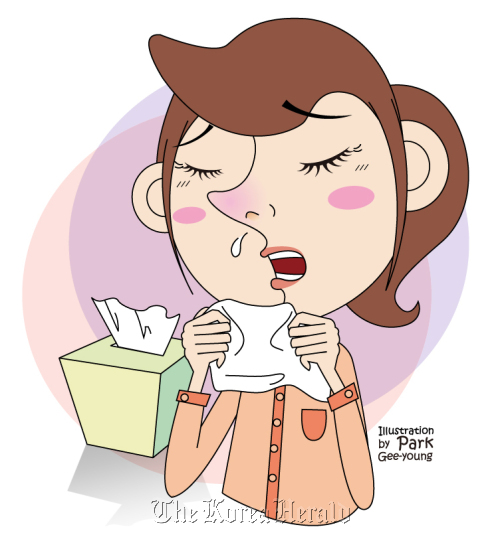
Cause
Hemophilus influenza and Streptococcus pneumoniae are the most frequent bacterial causes of acute bronchitis. However, in Korea, Mycobacterium tuberculosis can also be a cause. There are also many viral strains that induce the condition, and, rarely, fungal infections can, too.
Elderly people, infants and people who have had tuberculosis or pleural surgery are more susceptible to acute bronchitis. The incidence can increase during flu epidemics. If a fever lasts more than 2-3 days and coughing does not stop, patients should visit a doctor.
Symptoms
Acute bronchitis usually begins with coughing and a fever. As the condition advances, the coughing becomes severe, causing pain in the throat, chest, throat edema and dyspnea. Acute bronchitis in infants frequently progresses into bronchiolitis and pneumonia, along with fever, dehydration, shortness of breath and chest pain.
Treatments
The treatment for acute bronchitis varies according to the cause and symptoms. When a bacterial or viral infection is the cause, antibiotics and antiviral drugs can be selectively used, and fever reducers should be used when necessary. Bronchodilators ― drugs that expand the airways ― should be taken if the patient has their breathing obstructed or has an excess of mucus.
In case of severe cough, cough suppressant drugs can help reduce the severity of coughing and local anti-inflammatory drugs may also be used. But when cough suppressants are used, those containing codeine should be used only in special cases. For example, if the patient cannot sleep because of their severe cough.
Usual Habits
In order to prevent acute bronchitis, the person should rest and eat well to ensure sufficient nutrition. Drinking more water and also using a humidifier to maintain a suitable indoor humidity are also helpful. During this, the water bucket and the water of the humidifier should be clean and should not be contaminated by bacteria, fungi and dust. Third, the person should neither smoke nor be exposed to second-hand smoke.

By Kim Ho-joong, MD., PhD.
The author is a doctor at Division of Pulmonary and Critical Care Medicine of Samsung Medical Center and professor at Sungkyunkwan University School of Medicine. ― Ed.
-
Articles by Korea Herald







![[Graphic News] More Koreans say they plan long-distance trips this year](http://res.heraldm.com/phpwas/restmb_idxmake.php?idx=644&simg=/content/image/2024/04/17/20240417050828_0.gif&u=)
![[KH Explains] Hyundai's full hybrid edge to pay off amid slow transition to pure EVs](http://res.heraldm.com/phpwas/restmb_idxmake.php?idx=644&simg=/content/image/2024/04/18/20240418050645_0.jpg&u=20240419100350)






![[From the Scene] Monks, Buddhists hail return of remains of Buddhas](http://res.heraldm.com/phpwas/restmb_idxmake.php?idx=652&simg=/content/image/2024/04/19/20240419050617_0.jpg&u=20240419175937)

![[KH Explains] Hyundai's full hybrid edge to pay off amid slow transition to pure EVs](http://res.heraldm.com/phpwas/restmb_idxmake.php?idx=652&simg=/content/image/2024/04/18/20240418050645_0.jpg&u=20240419100350)

![[Today’s K-pop] Illit drops debut single remix](http://res.heraldm.com/phpwas/restmb_idxmake.php?idx=642&simg=/content/image/2024/04/19/20240419050612_0.jpg&u=)